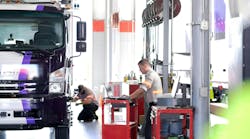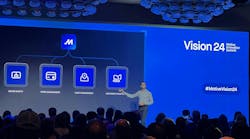How does a fleet manager dealing with today's brush fires find the time to gaze into the crystal ball long enough to predict business volumes and then make the appropriate equipment acquisition or disposition decisions to match anticipated freight demand. Done properly, the business grows profitably. Miss the forecast and you're either turning down loads or parking your rigs - neither of which is an acceptable alternative.
Complicating the effort are the accelerated inventory turns most manufacturers are now employing. That has reduced the standard six-month lead times fleets traditionally had to adjust capacity. Today, the business belongs to the nimble and quick.
As good as business is, and it is good, and as much as many fleets want to expand capacity, many are taking a conservative approach. "I'm just not confident I can fill the seats," says the president of a 31-unit regional truckload carrier. "That's what's keeping me from buying new trucks."
While business modeling systems that can predict freight demand are in place, most fleet managers remain skeptical. "A model is a model," says Leo Bluemenauer, president of Advance Distribution Services. "It provides no specific information."
Instead of relying on such sophisticated modeling systems, most fleets have developed their own internal systems.
Take USXpress. Max Fuller has built an internal model that allows him to keep his finger on the pulse of future traffic volumes six months out. He factors in the American Trucking Assns.' freight tonnage index to determine where freight volumes are going to be. He evaluates key economic indicators. And he listens to the voice of the customer.
By constantly monitoring business cycles within key segments - deferred air freight, for example - or specific commodity trends, such as personal computers, he can anticipate business trends and be positioned to respond. Also factored in are seasonality, geography, and product-specific details.
For instance, with personal computers accounting for a chunk of his business, Fuller realizes that shipments will drop in the first quarter as retailers attempt to clear shelves of models in anticipation of new chip technology. Knowing this, he is not caught flat-footed but instead repositions his fleet for other business.
His philosophy: "We will not participate in a slowdown. If we see business slacking off, we will increase our marketing efforts and chase down new business."
That worked during the last soft market back in 1995. Despite a drop in business, USXpress actually grew at a 17% clip.
Armed with expected business volumes, Fuller negotiates three-year deals with key suppliers, averaging 45 new power units a week and 450 trailers a month. Today, the average USXpress truck is only a year old. His contracts allow him flexibility to opt out of 10% of his order or increase it by a like amount.
Similarly, Herb Schmidt, sr. vp-sales and marketing for Contract Freighters Inc., a fleet of 2,000 power units, evaluates economic trends and cuts that against its internal sales forecast and historical data. But before rushing out to buy equipment, the company does a gut check to ensure it the needed cash won't be diverted to other strategic purposes like a new building or new technology that would crimp expansion plans.
CFI's strategy is simple: "I want to have more freight than I can handle regardless of the number of trucks," says Schmidt. "That way I can weed and feed. You can choose not to do business with the customers that pay the least. The best-paying ones you want more of."
This home-style forecasting has worked so far, allowing CFI to achieve double-digit growth in business volumes. As a hedge against cyclical freight downturns, Schmidt turns to transportation brokers well in advance to fill his trucks and keep them rolling. "You just can't wait until the last minute because all the loads will be gone," he says.
Another hedge against over-expansion is the company's reliance on owner-operators. Of the more than 2,000 units flying the CFI banner, more than 350 are independent contractors.
But Schmidt is careful to emphasize that CFI will not grow for the sake of growth. "We want to grow smart," he says.
At Skyway Freight Systems, president Chuck Lounsbury conducts quarterly sessions with customers to review strategic plans and ensure that he has enough capacity to handle their new business plans such as promotions or new stores.
His goal is to never have more assets than he has base business. That way, "customers are not paying for assets they're not using," he says. He uses leasing and contracts with other asset providers to ramp up and down according to business fluctuations.
Advance Distribution Services' Leo Bluemenauer, doesn't use any fancy forecasting tools to build his Columbus, Ohio-based fleet of 620 tractors. "We've found that the best way to forecast freight volumes is to keepin close touch with customers. Bluemenauer has developed his own model, which is fed by specific information provided by his customers."
"We're not forecasting out that far on purchases," admits Gary Davis, president of Davis Transfer in Atlanta. "We discuss it, but we're not pulling the trigger that far out.
"We play off the major carriers," says Davis, who has built his 143-unit fleet primarily by buying used equipment.
Plus, it gives him pricing leverage similar to the big carriers. So far this year, he has added about 25 power units and 125 trailers to his fleet by taking the extras off the hands of fleets and dealers.
The other advantage to Davis' approach is that he can ride the spec'ing of the bigger fleets. Because of his size, Davis feels he can't build a truck as well as some of the bigger boys. "There's no way I could run the kind of tests and equipment evaluations they do," he says. By taking their overflow, he gets the benefit of their specs.
Likewise, Billy Hart, owner of Hart Transportation in Jacksonville, started his business five years ago with five units. He has parlayed that investment into a $5-million company operating 40 power units and 60 trailers. How?
"We look at history with our existing customer base and we look at seasonality," he says. "Open dialogue is pretty important." So close is Hart to his core customers that he's viewed as the exclusive carrier in given lanes.
Looking at a shorter time frame, Sabre offers OptiYield, a tool that looks at business trends in the 10-14 day range to position existing equipment correctly. By examining historical freight demand, seasonality, day of the week, and the various commitments a fleet has made to its customer base, Sabre has developed a decision support tool that will allow fleets to choose the right place to position their equipment and solicit the most profitable freight.
"Typically, customer service reps will accept any freight regardless of how well it pays," says Ron Lazo, product manager. "Their object is to fill trucks and it's been done totally on intuition." OptiYield is designed to take the guesswork out and guide the solicitation of freight and load acceptance. In the process it helps balance the system and reduce empty miles. All that translates into a 5-7% savings, according to initial results from two fleets, one operating 600 power units and the other 4,000.
Tesco, the largest food retailer by market share in the United Kingdom, was out to improve customer service in its stores across England by upgrading the distribution of frozen foods through its existing supply chain. So the company turned to IBM to build a model of the existing chain and test several scenarios to improve it.
The result? The Supply Chain Analyzer, a software tool for examining the flow of goods from manufacturer to retail outlet. The program evaluates all the components and variables in a supply chain and helps Tesco determine which strategies or tactics will provide the most flexible and profitable operating environment.
The program confirmed Tesco's decision to restructure its frozen food distribution network.
Operating on the Windows NT platform, the Analyzer enables companies to model the following processes:
* Fluctuating customer orders;
* Conversion and assembly facilities and inventory of raw materials and finished goods;
* Distribution centers and retail stores;
* Transportation delays, routes, carriers and costs using a variety of transportation options;
* Periodic setting of inventory target levels;
* Product forecasts;
* All facets of supply planning.
"The Analyzer has been proven to save money while increasing customer satisfaction and reducing overall risk," says Bill Paulk, vp-supply chain solutions for IBM Global Industries. "It's an effective tool for companies to assess the impact of structural and policy decisions on product flows and financials before selecting and implementing a strategy.


